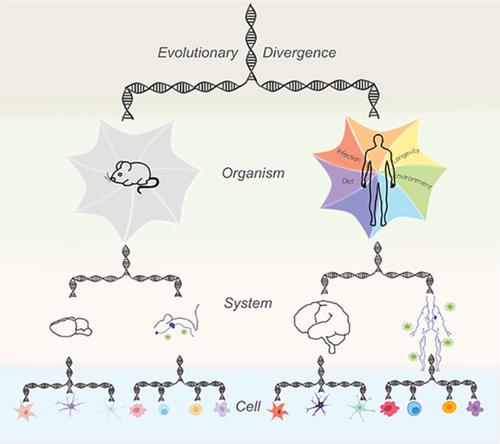Our official English website, www.x-mol.net, welcomes your feedback! (Note: you will need to create a separate account there.)
Species differences in immune-mediated CNS tissue injury and repair: A (neuro)inflammatory topic.
Glia ( IF 6.2 ) Pub Date : 2019-11-14 , DOI: 10.1002/glia.23746 Luke M Healy 1 , Moein Yaqubi 1 , Samuel Ludwin 1, 2 , Jack P Antel 1
Glia ( IF 6.2 ) Pub Date : 2019-11-14 , DOI: 10.1002/glia.23746 Luke M Healy 1 , Moein Yaqubi 1 , Samuel Ludwin 1, 2 , Jack P Antel 1
Affiliation

|
Cells of the adaptive and innate immune systems in the brain parenchyma and in the meningeal spaces contribute to physiologic functions and disease states in the central nervous system (CNS). Animal studies have demonstrated the involvement of immune constituents, along with major histocompatibility complex (MHC) molecules, in neural development and rare genetic disorders (e.g., colony stimulating factor 1 receptor [CSF1R] deficiency). Genome wide association studies suggest a comparable role of the immune system in humans. Although the CNS can be the target of primary autoimmune disorders, no current experimental model captures all of the features of the most common human disorder placed in this category, multiple sclerosis (MS). Such features include spontaneous onset, environmental contributions, and a recurrent/progressive disease course in a genetically predisposed host. Numerous therapeutic interventions related to antigen and cytokine specific therapies have demonstrated effectiveness in experimental autoimmune encephalomyelitis (EAE), the animal model used to define principles underlying immune-mediated mechanisms in MS. Despite the similarities in the two diseases, most treatments used to ameliorate EAE have failed to translate to the human disease. As directly demonstrated in animal models and implicated by correlative studies in humans, adaptive and innate immune constituents within the systemic compartment and resident in the CNS contribute to the disease course of neurodegenerative and neurobehavioral disorders. The expanding knowledge of the molecular properties of glial cells provides increasing insights into species related variables. These variables affect glial bidirectional interactions with the immune system as well as their own production of "immune molecules" that mediate tissue injury and repair.
中文翻译:

免疫介导的中枢神经系统组织损伤和修复的物种差异:(神经)炎症主题。
脑实质和脑膜间隙中的适应性免疫系统和先天免疫系统的细胞有助于中枢神经系统(CNS)的生理功能和疾病状态。动物研究表明,免疫成分以及主要的组织相容性复合物(MHC)分子参与神经发育和罕见的遗传疾病(例如,集落刺激因子1受体[CSF1R]缺乏症)。全基因组关联研究表明,免疫系统在人类中具有可比的作用。尽管中枢神经系统可以成为原发性自身免疫性疾病的靶标,但目前尚无任何实验模型能够捕获此类多发性硬化症(MS)中最常见的人类疾病的所有特征。这些特征包括自发发作,对环境的影响,以及遗传易感宿主中的复发/进行性疾病病程。与抗原和细胞因子特异性疗法有关的许多治疗性干预措施已证明可在实验性自身免疫性脑脊髓炎(EAE)中发挥作用,EAE是用于定义MS免疫介导机制基础的动物模型。尽管两种疾病有相似之处,但大多数用于改善EAE的治疗方法均未转化为人类疾病。正如在动物模型中直接证明并在人体中进行的相关研究所暗示的那样,系统性区室中以及驻留在中枢神经系统中的适应性和先天性免疫成分助长了神经退行性疾病和神经行为障碍的病程。对神经胶质细胞分子特性的不断了解,为与物种相关的变量提供了越来越多的见识。这些变量影响神经胶质与免疫系统的双向相互作用,以及它们自身产生的“免疫分子”,它们介导组织损伤和修复。
更新日期:2019-11-14
中文翻译:

免疫介导的中枢神经系统组织损伤和修复的物种差异:(神经)炎症主题。
脑实质和脑膜间隙中的适应性免疫系统和先天免疫系统的细胞有助于中枢神经系统(CNS)的生理功能和疾病状态。动物研究表明,免疫成分以及主要的组织相容性复合物(MHC)分子参与神经发育和罕见的遗传疾病(例如,集落刺激因子1受体[CSF1R]缺乏症)。全基因组关联研究表明,免疫系统在人类中具有可比的作用。尽管中枢神经系统可以成为原发性自身免疫性疾病的靶标,但目前尚无任何实验模型能够捕获此类多发性硬化症(MS)中最常见的人类疾病的所有特征。这些特征包括自发发作,对环境的影响,以及遗传易感宿主中的复发/进行性疾病病程。与抗原和细胞因子特异性疗法有关的许多治疗性干预措施已证明可在实验性自身免疫性脑脊髓炎(EAE)中发挥作用,EAE是用于定义MS免疫介导机制基础的动物模型。尽管两种疾病有相似之处,但大多数用于改善EAE的治疗方法均未转化为人类疾病。正如在动物模型中直接证明并在人体中进行的相关研究所暗示的那样,系统性区室中以及驻留在中枢神经系统中的适应性和先天性免疫成分助长了神经退行性疾病和神经行为障碍的病程。对神经胶质细胞分子特性的不断了解,为与物种相关的变量提供了越来越多的见识。这些变量影响神经胶质与免疫系统的双向相互作用,以及它们自身产生的“免疫分子”,它们介导组织损伤和修复。



























 京公网安备 11010802027423号
京公网安备 11010802027423号